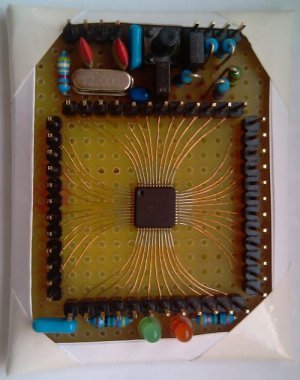I am having issues programming the MSP430F5529 on my own prototype board.
I took a look at the MSp430F5529 LaunchPAD User guide (SLAU533c) and found the following:
-
2.5 Using the eZ-FET lite Emulator With a Different Target
The eZ-FET lite emulator on the F5529 LaunchPad can interface to most MSP430 derivative devices, not just the on-board F5529 target device.
To do this, disconnect every jumper in the isolation jumper block. This is necessary because the emulator cannot connect to more than one target at a time over the Spy-Bi-Wire (SBW) connection.
Next, make sure the target board has proper connections for Spy-Bi-Wire. Note that to be compatible with SBW, the capacitor on RST/SBWTDIO cannot be greater than 2.2 nF. The documentation for designing MSP430 JTAG interface circuitry is the MSP430 Hardware Tools User's Guide (SLAU278).
Finally, wire together these signals from the emulator's side of the isolation jumper block to the target hardware:
-
3.3V
-
GND
-
5 V (if needed)
-
SBWTDIO
-
SBWTCK
-
TXD (if the UART backchannel is to be used)
-
RXD (if the UART backchannel is to be used)
-
CTS (if hardware flow control is to be used)
-
RTS (if hardware flow control is to be used)
This wiring can be done either with jumper wires or by designing the board with a connector that plugs into the isolation jumper block.
-
Very confusing.....
The Evaluation kit does not have these signals. I have Rev 1.6 of the MSP430 F5529 LaunchPAD Evaluation kit. It has the following:
GND
5V
3V3
RTS >>
CTS <<
RXD <<
TXD >>
SBW RST
SBW TST
THIS MEANS THE DOCUMENT IS OLD....or the PCB is wrong.
WIRING
Moving on ... assuming the PCB is corect....I have wired up the following to my prototype board.
ez-fet prototype board
gnd to god
3V3 to 3V
RXD to UART TX ( Pin 55)
TXD to UART RX ( Pin 51)
SBW RST to RST (pin 76)
SBW TST to TEST (pin 71)
ERROR I GET
I am using ENegia version 1.6.10E18 to connect to the target. The command line error I am getting is the following:
command-line>:0:12: warning: missing whitespace after the macro name [enabled by default]
Sketch uses 946 bytes (0%) of program storage space. Maximum is 131,072 bytes.
Global variables use 18 bytes (0%) of dynamic memory, leaving 8,174 bytes for local variables. Maximum is 8,192 bytes.
DSLite version 6.2.1.1594
Configuring Debugger (may take a few minutes on first launch)...
Initializing Register Database...
Initializing: MSP430
Executing Startup Scripts: MSP430
Connecting...
error: MSP430: Error connecting to the target: Unknown device
Failed: Operation was aborted
the selected serial port Failed: Operation was aborted
does not exist or your board is not connected
Clearly the documentation is different then the evaluation Kit. But I am unclear as to why this is not working.
Any help would be great. How can I get the launchpad ez-fet to connect to my prototype board?


